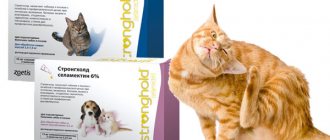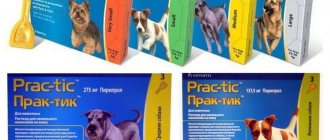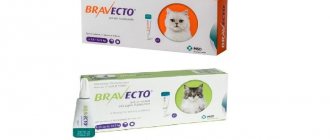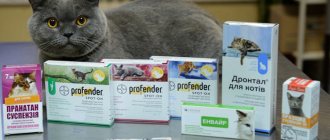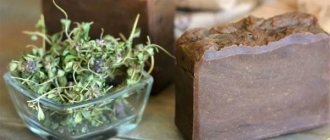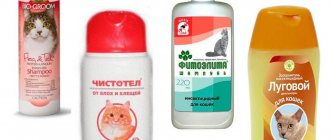Side effects
Flea drops are not highly toxic, and if you notice that your pet has licked a little of the drug, there is no need to worry. Nothing serious will happen. For prevention, you can rinse your tongue and mouth with running water. However, if you did not follow the rules of application, and the cat licked large quantities of flea drops, the following side effects may occur:
- itching;
- allergic reaction;
- shiver;
- weakness;
- refusal of food;
- vomit;
- weight loss;
- temperature;
- lacrimation;
- severe salivation (sometimes until foam appears).
Your actions in case of poisoning must be immediate. For the first two days, you need to give your pet warm water and liquid food. Immediately after side effects appear, the animal should be bathed in warm water with shampoo, wiped dry and create comfortable conditions for rest. If drops get on the mucous membranes of the eyes or mouth during treatment, rinse the damaged area with boiled water.
In the event that symptoms of poisoning last more than two days, self-medication should be stopped and professional help should be sought.
Overdose
Poisoning of dogs and cats with flea drops is extremely rare (3-5% of cases); the risk group includes sick, elderly, weakened animals, puppies and kittens.
Symptoms:
- drooling, increased sweating;
- vomiting (more often in dogs), nausea, diarrhea;
- uncontrolled eye movements, constriction of the pupils;
- trembling, shortness of breath, lethargy;
- frequent urination, fecal incontinence.
At the first manifestation of alarming symptoms, it is necessary to show the animal to a veterinarian. If it is not possible to do this immediately, you should give your pet a sorbent (activated carbon) to drink. Dosage: 1 tablet per 10 kilograms of weight. Plain water will help alleviate the severity of intoxication; it should be poured into the mouth every 15 minutes, 5-10 milliliters. There is no point in gastric lavage or enema - the drops are absorbed through the skin. If the condition worsens or dangerous symptoms increase (convulsions, shortness of breath), a visit to the clinic is essential to avoid the death of the animal. In a hospital setting, the doctor administers intramuscular or intravenous steroids to eliminate allergic manifestations, and prescribes IVs to promptly remove toxins, which improves the condition of the animal.
Flea drops are the drugs of choice for protection against blood-sucking parasites. They are effective, safe and affordable. The main thing is to adhere to simple rules: strictly adhere to the dosage, frequency and application technology. To enhance the effectiveness of the drops, it is recommended to use an anti-flea collar as an additional means.
How can you tell if a cat has licked drops?
Flea drops Bars or any other are an effective remedy for fighting parasites. This medicine must be applied to the withers so that the cat cannot lick them off. If this happens, the animal may become ill. Of course, the furry pet will not die after this, but cat poisoning is quite possible. If a pet that has been treated with anti-flea drops does not experience any discomfort, it means that the drug did not have any effect on it. A poisoned animal looks bad and behaves very lethargically. Also, after the cat licks the drops and they take effect, he may have loose stools. Sometimes diarrhea lasts 3-4 hours, and in some cases - for 2-3 days. Even if the diarrhea disappears, this does not mean that the poisoning has passed.
When intoxicated with anti-flea drops, pets lose their appetite and noticeably lose weight, but the desire to drink, on the contrary, may increase. Quite often there is excessive salivation, sometimes even foaming at the mouth. A cat that has licked drops of fleas loses orientation in space (it takes a long time to try to jump). Also, the animal’s pupils dilate, and the sensitivity of the limbs partially disappears. It becomes very difficult for cats to retract their claws.
Sometimes other symptoms of intoxication may be observed:
- the appearance of severe itching, which is accompanied by allergic reactions;
- the occurrence of excessive tearing;
- bald patches that form in areas exposed to flea drops.
If, after treatment with drugs against parasites that are applied to the animal’s withers, the pet develops any of these symptoms, then it is necessary to urgently seek medical help.
Visit doctor
After carrying out all the necessary manipulations, you should take the kitten to the nearest clinic. To simplify diagnosis and prescribe therapy, it is recommended:
- At the first symptoms of poisoning in a kitten, you should show it to a veterinarian
if possible, take with you a sample of the suspected poisonous product (a small portion of food or liquid, medication packaging, a sprig of a poisonous plant);
- collect the remaining vomit in a bag or sealed container;
- calculate the approximate amount of poison swallowed;
- remember and describe the stages and rate of development of symptoms, all manifestations of pathology, the presence of concomitant diseases or allergies to medications in the kitten;
- If you suspect intoxication with waste products of helminths, collect a small amount of feces.
The veterinarian will conduct a visual examination of the pet,, if necessary, prescribe laboratory and instrumental examinations and prescribe treatment. In severe cases, detoxification therapy may be required in the form of IVs or injections, as well as surgery.
Ways to combat parasites in kittens of different ages
Every owner wants to free his ward from uninvited guests as efficiently and carefully as possible. There are different ways to control fleas:
- mechanically clean - bathe and remove fleas manually or by combing; You can remove fleas from a kitten by combing
- wash the kitten with antiparasitic shampoo;
- apply other antiparasitic agents;
- choose gentle folk recipes.
In kittens up to 1 month
At the age of up to 1 month, the kitten is not yet ready for potent drugs; its immunity is weak and susceptible to infections and diseases. Therefore, our recommendation would be to postpone the fight against bloodsuckers until the age of 3-4 months, if there are still few fleas. Only if the animal is constantly itching and tearing the skin with its claws can mechanical treatment begin:
- Wash the old bedding and put on a new one.
- Vacuum and wash the area where the kitten lives.
- Comb out parasites with a fine-toothed comb. Parasites on a kitten should be combed out with a fine-toothed comb.
Try to do these manipulations as often as possible - preferably every day. Such procedures will alleviate the kitten’s condition and delay the use of antiparasitic drugs.
In kittens up to two months
If the kitten’s condition is deplorable, and you can’t wait to help your pet, find flea shampoo for kittens up to two months on sale.
You need to wash your kitten with flea shampoo as follows:
Start by trimming your pet's nails, otherwise your hands could get pretty damaged. Check that there are no drafts and that the house is warm. Cats get very cold after bathing. Then prepare the necessary tools: a basin (bath), shampoo, a comb for combing and a towel. Hold the kitten and, gently talking and stroking it, place it in a bowl of warm water (38–42 °C). Begin to calmly and confidently wash the kitten from head to toe. To prevent water from getting into your ears, carefully insert cotton swabs into them, and apply a drop of Vaseline to the teardrops of your eyes with a cotton swab. As soon as the fur is wet, apply the diluted shampoo to the kitten's body and paws, lather thoroughly and hold for 7-8 minutes. To remove fleas, apply shampoo to the kitten's fur and leave for 7-8 minutes. Then rinse the kitten under running water. Please note that rinsing off shampoo is a thorough and mandatory process.
Rinse for 5-7 minutes, otherwise the shampoo may not be washed out, and the animal will be poisoned when licking it from the fur. After washing, you need to properly rinse the shampoo from the kitten’s fur so that the animal does not get poisoned when licking. Immediately after rinsing the shampoo, place the pet in a towel, it will begin to tremble, it is important to wrap and warm the baby. You can start combing out fleas with a comb right in the towel. They are clearly visible in wet wool. Wipe, dry, caress the kitten - it has gone through a lot of stress.
In kittens after 2–3 months
Your pet has grown up, and the arsenal of means to combat bloodsuckers has grown. Now you can use drops on the withers, a collar for prevention, flea sprays or folk recipes for removing parasites from a kitten’s fur.
Prevention
To prevent licking, apply drops according to the instructions.
If there are several animals, they are isolated or put on an Elizabethan collar. The insecticide is purchased in specialized stores. You should not use budget options. Advantage, Frontline or Advocate are effective and low-toxic drugs for killing fleas. Water deactivates the insecticidal effect of the drops, so the pet should not be wetted for the first four days.
It is unacceptable for the active component of the anti-flea agent to enter the bloodstream from the digestive tract. If a cat licks a friend treated against insects, it will be poisoned. In order for the contents of the drops to become insoluble, they must be allowed to dry. When there are several animals, they are isolated or an Elizabethan collar is used.
https://zelenplaneta.ru/blohi/chto-delat-esli-kot-slizal-kapli-ot-bloh.htmlhttps://notklop.ru/blohi/blohi-u-koshek/koshka-slizala-kapli-ot- bloh/https://apest.ru/blohi/blohi-u-koshek/koshka-slizala-kapli-ot-bloh/https://parazitdoma.ru/sovety/koshka-slizala-kapli-ot-blohhttps:// localvet.ru/koshki/simptomy/kot-slizal-kapli-ot-bloh
Main brands of cat collars
Which flea collar to buy for cats is a personal matter for each owner
But it is worth paying attention to the following nuances. When choosing a manufacturer, first of all, you should pay attention to how much the anti-flea collar costs.
As a general rule, a product that is too cheap cannot be of high quality and effective. And in favor of products made in Germany and the USA is the fact that if production standards are violated, the manufacturing plant faces heavy fines, so products from these countries comply with all established standards.
According to reviews from experienced veterinarians and cat lovers, the following types, out of many on the market, are considered high-quality products:
- Hartz: American made product that works effectively even when wet. Hartz repels and destroys blood-sucking pests. There are practically no adverse reactions to the product in animals;
- Bolfo: has a long shelf life, justifying the fairly high cost. High quality and waterproof;
- Beaphar: one of the most effective and safe preventatives. There are products for small kittens. Beafar belongs to the family of natural collars;
- Bars and Doctor Zoo: effective and relatively safe products made in Russia. The disadvantages include a large number of fakes that are unsafe for cats.
Carefully choose a flea accessory for cats to protect your pet from the invasion of unpleasant parasites and not cause additional harm to him before buying it.
To make the right choice, it is important to know and understand how a flea collar works. Fleas, lice eaters, ticks - there are many small pests that cause harm to pets and their owners, but in the modern world everything has been done to get rid of them quickly, simply and safely
The right anti-flea collar is an excellent means of preventing the appearance of unpleasant roommates. The main thing is to start acting on time.
Drops "Clandestine" against fleas and ticks for dogs and cats: description
“Clandestine” for fleas and ticks for cats and dogs is an insecticidal drug. The medicine is suitable for both exterminating pests and preventing their occurrence. The product is easy to use and safe if the recommended dosages and safety precautions are followed.
Composition and release form
“Clandestine” is sold in the form of an oily solution of a light yellow hue. If used incorrectly, it irritates the mucous membranes of the respiratory tract. Main components: fipronil (5%) and permethrin (1%). Additional components: dimethyl sulfoxide, propylene glycol, polyvinylpyrrolidone, isopropyl alcohol.
Indications for use
Celandine drops are used for cats and dogs from 2 months of age to destroy external parasites:
The drug can also be used for preventive purposes. In this case, the animal is treated with drops once a month during the period of parasite activity - from February to March and from October to November.
Effect on parasites
The main components of the drug - fipronil and permethrin - are aimed at causing paralysis of muscle tissue and nerve cells in bloodsuckers, thereby causing their death.
The substances do not enter the bloodstream of animals. The effect of using drops is achieved due to the fact that the components accumulate on the epidermis, fur and sebaceous glands of the pet. After the first contact with the drops, ticks and fleas die without harming the animal itself.
Types of drops "Clandestine"
There are several types of drops. They are divided into types based on the species of the animal and its age.
The following drugs are sold:
- drops for cats against ticks and fleas - 3 pipettes;
- drops for dogs against ticks and fleas - 4 pipettes;
- drops for kittens and puppies against ticks and fleas - 3 pipettes;
- universal drops against ticks and fleas - 5 milliliters.
Instructions for use and dosage
Drops are applied to those places where the animal cannot lick them. Usually this is the back of the head or neck. During processing, you must adhere to the correct dosage:
- for adult cats and dogs whose weight exceeds 2 kg, use 1 pipette for treatment;
- for kittens and puppies weighing less than 2 kg, half a pipette will be enough;
- for animals heavier than 10 kg you will need 2 ml of the drug;
- animals whose weight exceeds 20 kg are given 3 ml;
- cats and dogs heavier than 30 kg need to receive 4 ml of medication.
Processing algorithm:
- cut off the top of the pipette;
- spread the hair on the back of the head or neck;
- apply drops to the epidermis.
To ensure safety when using drops and get maximum effect, we recommend paying attention to the following tips:
- One application is enough to kill parasites. If necessary, the treatment can be repeated, but not earlier than after a week. It is advisable to consult a veterinarian before doing this.
- To prevent the appearance of ticks, the medicine is used less frequently - once every two months.
- On the first day after applying the drops, the animal should not be bathed and accidental contact with water must be avoided. Otherwise, the effectiveness of the procedure will be reduced.
- It is also recommended to treat the animal's bedding to prevent re-infestation.
- The day before treatment, you need to bathe the animal.
Has your cat been poisoned by flea drops?
Paralyze. Horror! His hind legs are not very mobile. Suddenly it paralyzes. Now we’d better buy him a collar.
Have you been treated? Or did it just go away? We think maybe we can give him some coal?
It seems like my father-in-law processed it according to the instructions. I think he overdose.
This could also happen, the middle foundling was treated with IVs, doctors came to the house, but we love animals and treatment at home is expensive. But they are like children, they don’t mind any money, but then they give such happiness!
I agree, in such cases the count goes down to hours and minutes.
Wow, I'm sorry. But you yourself wrote that you went too far with the dosage. And this is absolutely impossible to do. And at the first sign of poisoning, it was necessary to immediately run to the doctor, and not wait for the pet to die. I have been using Bars for many years and do everything according to the instructions, so my animals are healthy (alive) and free of fleas.
In order to be poisoned by Stronghold, you need to drink a couple of pipettes. Something else gave you intoxication, maybe worms
I would like to give advice to everyone who treats cats for fleas, worms, and ticks - give the animal activated carbon a couple of hours before treatment, and after treatment, 2 hours later, again give a tablet (by weight) of activated carbon.
The drops are not poison, if handled correctly, the poison is parasites (worms) that die from the drops and leave poisons in the animal’s body
CRF and TWO months? How can a chronic disease happen in TWO months? Any.
Use and reprinting of printed materials from the woman.ru website is possible only with an active link to the resource.
The use of photographic materials is permitted only with the written consent of the site administration.
Posting intellectual property objects (photos, videos, literary works, trademarks, etc.) on the woman.ru website is permitted only to persons who have all the necessary rights for such posting.
Copyright (c) 2016-2018 Hirst Shkulev Publishing LLC
Online publication “WOMAN.RU” (Zhenshchina.RU)
Certificate of registration of mass media EL No. FS77-65950, issued by the Federal Service for Supervision of Communications, Information Technologies and Mass Communications (Roskomnadzor) on June 10, 2016.16+
Founder: Limited Liability Company "Hirst Shkulev Publishing"
Editor-in-Chief: Voronova Yu. V.
Editorial contact information for government agencies (including Roskomnadzor):
What to do if your cat licked flea drops
One of the most effective methods of combating parasites is special drops. They help quickly get rid of fleas or ticks. Unfortunately, such products can harm not only parasites, but also animals. If a cat licks flea drops, the body may be poisoned. In this case, the pet will need help.
Main symptoms of poisoning
Flea drops are highly toxic drugs. This is why they are so effective in controlling harmful insects. By licking a certain amount of flea drops, a cat can get away with a slight illness or get seriously poisoned. It all depends on the animal’s immunity, its age, the general condition of the body and how much of the product has entered the stomach. The following signs usually indicate intoxication:
- The cat refuses food, does not even eat what it used to love.
- The animal constantly drinks water.
- There is increased salivation.
- The pet's pupils are greatly dilated.
- The cat is poorly oriented in space (it takes a long time to decide to jump, lick food from the owner’s palm, the animal skids and staggers). He doesn't retract his claws all the way (meaning his paws go numb).
- Diarrhea appears.
shutterstock
You should be able to distinguish between situations when a cat is poisoned by flea drops and when he is allergic to them. It can manifest as tearing, itchy skin, and bald patches in the area where the product was applied. Licking drops is one thing, but having an individual intolerance to them is quite another.
How to help your pet
Having noticed alarming symptoms, you need to try to alleviate the condition of a cat poisoned by flea drops as much as possible. Ideally, take the animal to the veterinarian and place it in the hands of a professional. However, this is not always possible, and it’s a shame to look at a cat. What to do in this case?
You can give the animal rice water. It is prepared by pouring one and a half tablespoons of cereal with half a liter of water and boiling over low heat for about forty minutes. The cooled and strained liquid is offered to the cat. Since he is constantly thirsty, most likely he will not refuse the medicine. Otherwise, the broth is poured inside the cat using a syringe.
Among medications for poisoning with flea drops, Smecta is used. Half a sachet of this drug is diluted with two tablespoons of water and poured into the mouth or offered to the animal as a drink. The danger to a cat can be significantly reduced by allowing the animal to lick half a tablet of regular activated carbon, crushed and dissolved in water.
It will draw out all toxins from the body. No-Shpa will help relieve the condition caused by the drops. The dose of this drug for an adult cat is also 0.5 tablets. But the intestinal microflora is perfectly restored by the prebiotic for animals “Vetelakt”. The specifics of its use are described in the attached instructions.
shutterstock
A cat that has been poisoned by flea drops should drink more. You can add a little potassium permanganate to the water if the incident occurred recently. Fatty, salty, sweet foods are contraindicated for the animal during this period. Most likely, the cat himself will refuse such food, because his appetite is practically zero.
Prognosis and prevention
All owners, without exception, are interested in how dangerous poisoning with flea drops is. Veterinarians reassure: the cat will not die if it has not swallowed a whole bottle of the product. Most likely, she was “lucky” to lick off quite a bit of the drug.
However, in this state the animal cannot be left without attention. Drop poisoning is a serious stress for the body that can provoke other dysfunctions. Old or sick individuals, as well as kittens, suffer the most from intoxication.
To avoid poisoning, you should drip the product exclusively onto the withers. This is the place where it is most difficult for an animal's tongue to reach. However, sometimes the cat licks drops from this place too - after all, the animal’s body is very flexible and dexterous. Therefore, it is not enough to simply apply the product to the withers in the required amount. Additional measures need to be taken. Let's say, put a special collar on the cat's neck, which will prevent the fluffy from licking himself.
It is not uncommon for several animals to live in one house. By treating one pet with fleas, it is easy to jeopardize the health of another. Animals tend to lick each other. When fighting fleas, you should keep your tailed pets separately.
Well, one last thing: you need to choose high-quality drops. And buy them in specialized pharmacies or stores. Poisoning with a low-grade flea remedy of dubious origin can have unpredictable consequences.
How to help your pet
Having noticed alarming symptoms, you need to try to alleviate the condition of a cat poisoned by flea drops as much as possible. Ideally, take the animal to the veterinarian and place it in the hands of a professional. However, this is not always possible, and it’s a shame to look at a cat. What to do in this case?
You can give the animal rice water. It is prepared by pouring one and a half tablespoons of cereal with half a liter of water and boiling over low heat for about forty minutes. The cooled and strained liquid is offered to the cat. Since he is constantly thirsty, most likely he will not refuse the medicine. Otherwise, the broth is poured inside the cat using a syringe.
Among medications for poisoning with flea drops, Smecta is used. Half a sachet of this drug is diluted with two tablespoons of water and poured into the mouth or offered to the animal as a drink. The danger to a cat can be significantly reduced by allowing the animal to lick half a tablet of regular activated carbon, crushed and dissolved in water.
It will draw out all toxins from the body. No-Shpa will help relieve the condition caused by the drops. The dose of this drug for an adult cat is also 0.5 tablets. But the intestinal microflora is perfectly restored by the prebiotic for animals “Vetelakt”. The specifics of its use are described in the attached instructions.
© shutterstock
A cat that has been poisoned by flea drops should drink more. You can add a little potassium permanganate to the water if the incident occurred recently. Fatty, salty, sweet foods are contraindicated for the animal during this period. Most likely, the cat himself will refuse such food, because his appetite is practically zero.
The cat licked flea drops from its fur
Only registered users have the ability to start new topics. Register and log in to the site by entering your username and password on the right side of the window, and you can start a new topic.
Before visiting the forum, read the topic: “How to consult a veterinarian correctly,” as well as the list of answers to frequently asked questions, this will help you save your time and get an answer to your question faster
Pay special attention to the document: Symptoms of animal diseases. Perhaps in your situation you cannot expect an answer on the forum, but you need to urgently call a doctor or take the animal to a veterinary clinic! Before joining the forum, read the following sections, this will help save your time and quickly get an answer to your question:
Before joining the forum, read the following sections, this will help save your time and quickly get an answer to your question:
Attention! Pay special attention to the document “Symptoms of Animal Diseases”. Perhaps in your situation you cannot expect an answer on the forum, but you need to urgently call a doctor or take the animal to a veterinary clinic!
Flea drops
At the moment, there are several of the most well-known manufacturers of flea drops. Their drugs differ in quality, price and duration of action. But there is one thing that unites them - toxicity.
All drops have a toxic effect, because they kill insects. It’s not for nothing that the instructions for the drug say that you need to drip where the animal cannot reach – on the withers. Unfortunately, manufacturers do not take into account the very flexible and resourceful cats, as well as their brothers - after all, cats can lick each other. Thus, it turns out that licking off flea drops is very possible.
At the moment there are several of the most well-known manufacturers of flea drops
Of course, if a cat licks the drops, it will not die. Still, there are not enough of them, she didn’t drink the whole package! But a cat can easily get poisoned.
You should read the article posted earlier on our resource, in which we talked about the types of flea drops for cats and the features of their application.

